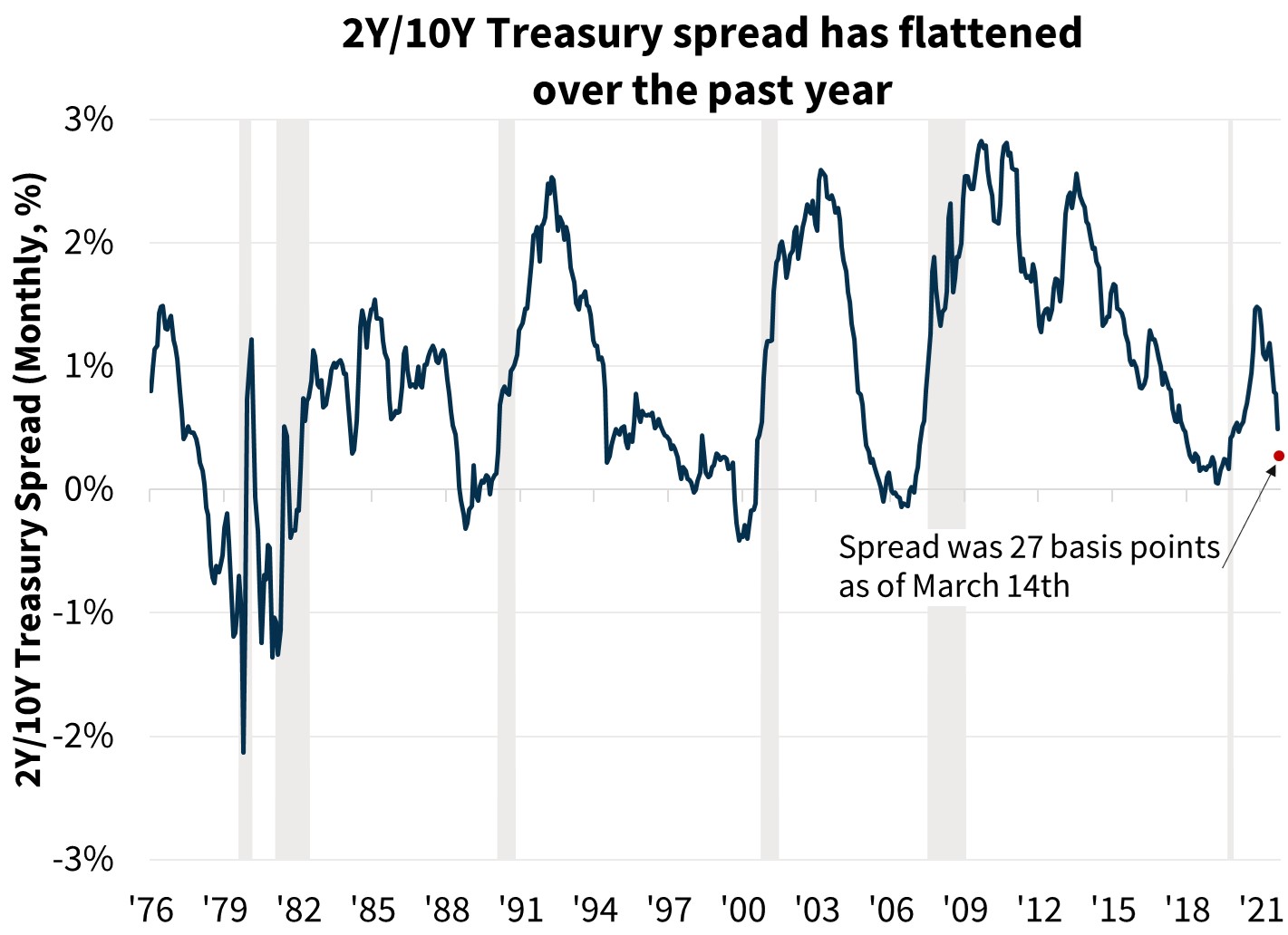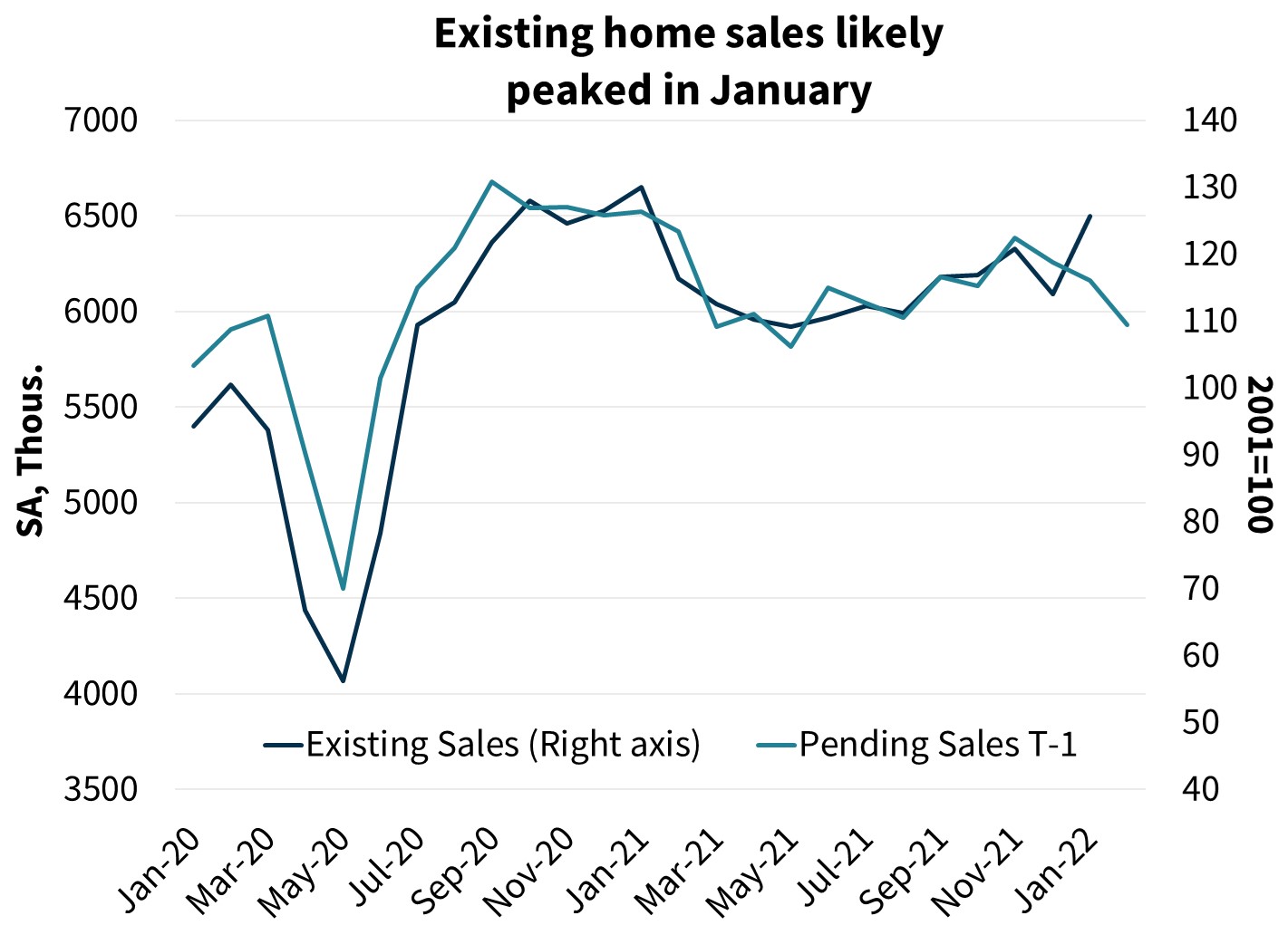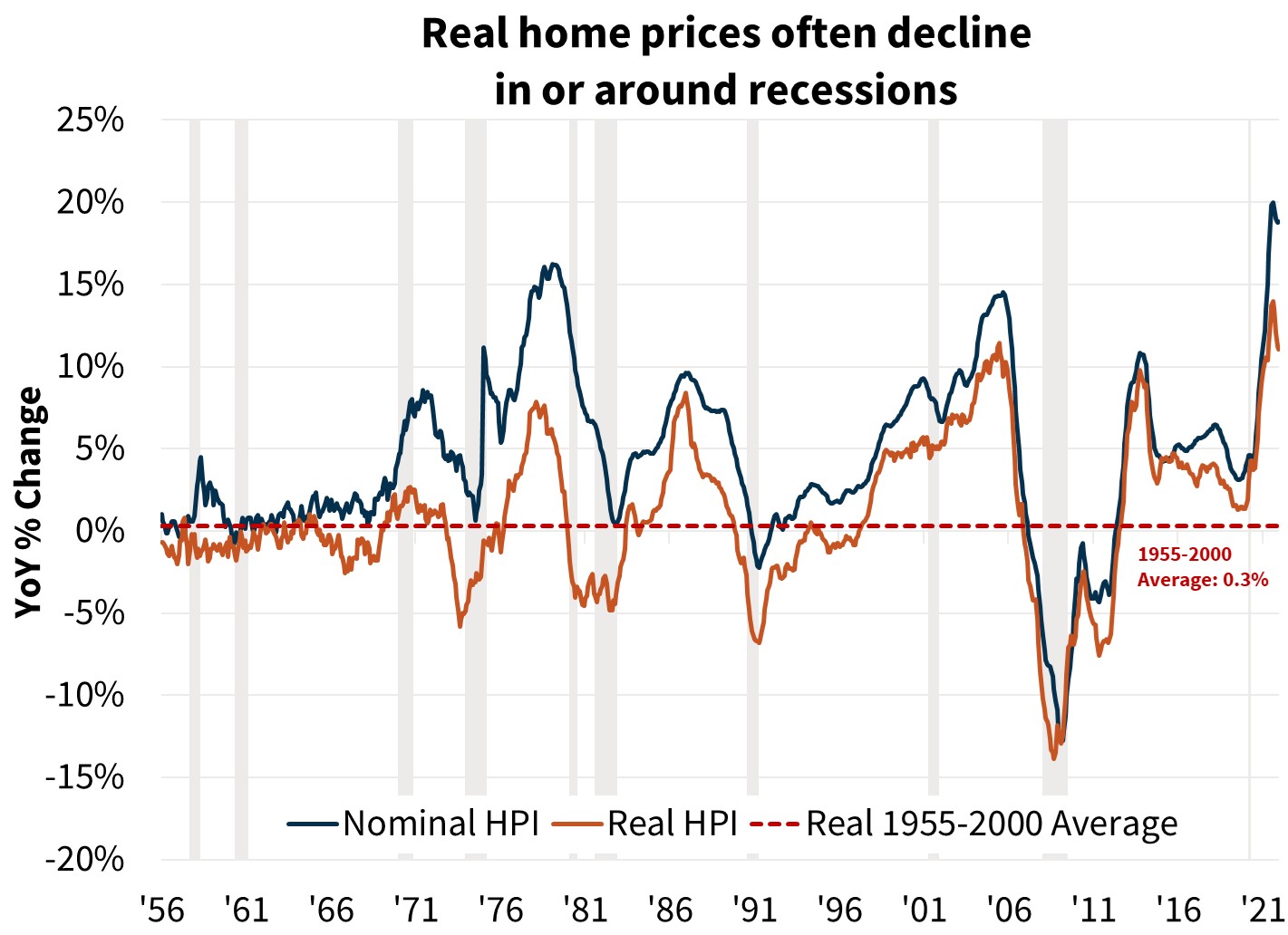Russia’s Invasion of Ukraine Complicates ‘Soft Landing’ for the Economy
The Russian invasion of Ukraine further complicates an economic landscape still affected by a pandemic, historically large monetary and fiscal policy responses, and the ensuing 40-year high inflation rate. Monetary policy tightening is now underway as the Federal Reserve changes direction to combat inflation in an attempt to arrive at a “soft landing” for the economy. Over the previous business cycle, the Fed’s intended tightening phase was short lived as financial market volatility rose and signs of slowing economic growth became apparent. With inflation still tame then, plans to tighten monetary policy further were quickly reversed in 2018. Today, the economy is already decelerating as the first rate hikes occur, and inflation is continuing to reach new generational highs. With the addition of uncertainty around the implications of the Ukraine conflict, these facts suggest that any macroeconomic forecast should be understood with a wide range of possible outcomes, including a significantly higher probability of recession.
Our baseline forecast assumes that oil and commodity price spikes will ease and that related supply chain disruptions and financial market volatility will be short lived. These are assumptions. Even with a near-term resolution to the hostilities, the economic implications represent a “stagflation” shock expected to weigh on growth while driving prices higher. We have downgraded our 2022 real gross domestic product (GDP) forecast by 0.5 percentage points to 2.3 percent, while maintaining our 2023 growth expectation of 2.2 percent. Our near-term inflation outlook as measured by the Consumer Price Index (CPI) was revised upward but still peaks annually on a quarterly average basis in Q1, though at a higher 8.0 percent (up from 7.6 percent). Our year-end 2022 inflation outlook was revised upward to 5.1 percent from 4.4 percent. We forecast the Federal Reserve’s preferred measure, the core PCE deflator, will end the year at 4.5 percent.
A combination of higher mortgage rates and a downgrade to expected economic growth led to a downward revision to our housing outlook. We now expect total home sales to decline 4.1 percent in 2022 (previously a decline of 2.4 percent). We still expect new home sales to remain robust as homebuilders work to bring their record high level of homes under construction to completion. In addition to the macroeconomic forecast changes leading to a slower expected pace for housing, we have also adjusted our outlook for the composition of new home construction. We now expect somewhat fewer single-family starts to occur through 2022. Our outlook for multifamily starts was upgraded by a nearly offsetting amount. We forecast single-family mortgage originations to total $3.0 trillion in 2022 and to total $2.7 trillion in 2023, down from our previous forecast of $3.2 trillion and $2.9 trillion, respectively. The changes were approximately evenly driven by purchase and refinance segments.
Many Unknowns Around Ukraine Implications
Beyond uncertainty over the duration and severity of the Ukrainian-Russian conflict itself, there is a progression of uncertainties with potential impacts to growth, inflation, and interest rates:
- Oil Prices – Oil prices have been extremely volatile over the past month, jumping as high at $135 per barrel before pulling back to a little over $100 as of this writing. At its peak, and depending on how its measured, this represented the largest oil price shock since the 1973 Iran embargo. How much Russian oil will ultimately be held off the global market either due to sanctions or boycotts is unknown. If a substantial amount is kept off given already low inventory levels, not only would this add to inflation, but it would likely translate into fewer energy-dependent economic activities occurring as the amount of oil products available to be used would fall. Some of the disruption may be made up for if an Iranian or Venezuelan sanction deal can be agreed upon, but neither country has the capacity to fully offset the potential size of the loss. OPEC and U.S. producers also face capacity constraints and perhaps may not have the willingness to meaningfully increase output in the short run.
- Agriculture Commodities – Beyond the impact that energy prices have on food prices via production and transportation, this conflict also has direct effects on food supply. Ukraine and Russia combined account for about 25 percent of global wheat exports, and fear of disruptions has led to a spike in futures prices. Fertilizer prices have also jumped, not only because natural gas is used in its production, but the two countries (plus Belarus) are major producers of this vital farm input. Hungary and Argentina have also recently announced restrictions on their own agricultural exports to curtail domestic food price gains, which may signal the start of a trend in global agriculture protectionism.
- Global Supply Chains and Shipping – While the U.S. economy has minimal direct exposure to Russia, the latter is a major global producer of industrial metals (including nickel and palladium used in auto manufacturing), and this could lead to further disruption of already stressed global supply chains. Of note, Ukraine is also a major supplier of industrial gases used to produce the laser equipment needed to manufacture semiconductors. Even if various materials can still be sourced elsewhere, aside from higher prices, this dislocation also promises to drive shipping costs higher.
- Financial Contagion – The U.S. has limited exposure to Russian financial institutions, but indirect impacts could occur. Sanctions are likely leading to counterparty risks for many non-Russian firms abroad, while the sharp ruble selloff and prospect of a sovereign debt default could ripple through the global financial system. The 1998 failure of Long Term Capital Management after a Russian debt default led the Fed to organize a bailout. The 1997 Asian Financial Crisis and the 1982 Latin American Debt crisis are also examples of currency and financial shocks that developed in one region and spread across the globe.
- Secondary Geopolitical Instability – Rising food and energy prices could lead to political instability elsewhere, especially in developing economies. It is often cited that rising food prices were a contributing factor to the “Arab Spring” in 2011. Other nations already facing severe inflation, such as Turkey, could ultimately see political crises domestically leading to additional adverse impact on the global economy.
- Net Effect on Interest Rates – There are several competing forces acting on interest rates. The U.S. Treasury market is viewed as having the lowest default risk in global financial markets. Thus, a “flight to safety” toward U.S. Treasuries often occurs during global risk spikes, pushing down rates. However, inflation pressures are also rising, threatening to drive an increase in long-run inflation expectations and worry that the Fed will have to respond with a more aggressive rate hike path. This could contribute to a move upward in longer-term interest rates. It is also unknown what the ultimate global capital flow implications are of sanctions on the Russian financial system and the freezing of Russia’s central bank foreign reserves.
- … And China is Locking Down Again Due to COVID – While attention has been given to the Ukraine conflict in recent weeks, COVID cases have begun to jump in China, and a lockdown of Shenzen, a major economic center, was recently announced. This also occurred in the context of continuing plummeting Chinese equity prices and growth worries. Together, this weighs on global demand while making supply chain disruptions worse.
The Fed Was in a Difficult Position Even Before Ukraine
Inflation hit another multi-decade high in February with the CPI rising to 7.9 percent on an annual basis, up from 7.5 percent in January. While base effects will be more favorable in keeping further annual acceleration muted, inflationary pressures are expected to continue even in an optimistic geopolitical scenario. In recent testimony, Chairman Jerome Powell stated that “Hindsight says we should have moved earlier,” perhaps pointing to a need to tighten more aggressively than ideally desired. In recent months, the slope of the yield curve, as measured by the 2-year/10-year Treasury spread, has flattened considerably to 27 basis points as of this writing. While it is not yet signaling it, an inversion of the yield curve has historically been one of the better indicators of a recession occurring over the next two years or so. Equity prices have also continued to sell off (the S&P is down 13 percent year to date as of this writing). Together, these metrics point to financial market apprehension as the Fed tightens. Historically, achieving a “soft landing” where inflation slows meaningfully without leading to an economic contraction is the exception rather than the rule.
If business confidence remains comparatively strong, firms will need to rebuild inventories, a source of demand for the economy this year. Recent data on capital goods shipments and orders points to near-term strength in business investment. Even so, first quarter real GDP growth is expected to be under 1 percent. This is largely due to a give-back from an unsustainable surge in inventory investment in Q4. The average of Q4 growth (7.0 percent annualized) and expected Q1 growth (0.8 percent annualized) is 3.9 percent, which we believe to be more representative of the recent growth pace. Consistent with that view, labor market indicators also remain strong, with 678,000 payrolls added in February and job openings remaining near all-time highs.
However, we do expect a near-term softening in consumer spending, the component that ultimately drives most growth. Real incomes are now falling due to inflation, and the household saving rate at 6.4 percent is below the pre-COVID norm of around 7.0-7.5 percent. Household balance sheets remain strong in part due to rising home prices, which could help bolster consumer spending despite rising consumer prices. We also continue to think that there is pent-up demand for auto purchases that have been held back by supply chain difficulties, as well as some services spending as remaining COVID restrictions are removed. However, it’s uncertain whether consumers will be willing to spend more broadly as interest rates rise and if consumer confidence measures deteriorate further. We are therefore expecting muted consumer spending growth through much of the year.
January Likely Marked Home Sales Peak
Existing home sales jumped in January by 6.7 percent to an annualized pace of 6.50 million units. This was above our expectations but followed a downward revision to December’s figure. Similarly, house prices as measured by the FHFA Purchase-Only Index were up 17.7 percent in December on an annual basis for the second month in a row following three months of deacceleration. We interpret this recent surge in housing activity around the turn of the year to have been partially driven by many prospective buyers rushing to lock in mortgages prior to expected jumps in interest rates. Fannie Mae’s February Home Purchase Sentiment Index® (HPSI) again reported a rising net-share of respondents expecting mortgage rates to rise, while surveys from Redfin and others point to a bringing-forward of purchase plans. More recent near-term indicators, consistent with a temporary surge view, suggest that January will be the near-term sales peak (on a seasonally adjusted basis). January pending sales, which lead closings on average by 30-45 days, fell 5.7 percent over the month. Similarly, purchase mortgage applications fell in February by 11.9 percent. Combined with the ongoing lack of supply of homes available for sale and growing affordability pressures, we expect existing home sales to slow considerably over the course of the year relative to the January pace. We expect existing sales to trend downward to a pace of about 5.6 million annualized units by the end of the year, compared to the Q4 2021 average of 6.2 million units.
New home sales are still expected to remain robust as homebuilders are actively working to bring more homes to completion after ongoing supply chain and labor-related delays. Major publicly traded homebuilders continue to guide a significant increase in sales and lot developments in 2022, while a record number of homes are currently under construction. However, we modified modestly our expectation for the mix of housing types. We now expect multifamily starts to total 465,000 units in 2022 (up from a previous 442,000), while expecting single-family housing starts to average 1.15 million units (compared to a previous 1.17 million).
For more on multifamily market conditions, please see the March 2022 Multifamily Market Commentary.
Geopolitical and monetary policy uncertainty add risk to the housing outlook. With affordability declining, a significant further rise in mortgage rates would price many buyers out of the market. In the short run, the prevalence of bidding wars and a lack of inventory for sale leads us to believe that further rate increases will have a comparatively muted effect on sales relative to the historical rate change relationship. We expect transactions will still occur due to a reserve of currently outbid buyers being available to fill the gap as others are priced out. In our view, this will likely lead to fewer bidding wars and decelerating price gains. We believe this comparative resilience will be temporary, though, as eventually this pool will be exhausted. This is especially true given we expect that many recent purchases represent buyers moving forward their plans, meaning future demand will soften at some point. Conversely, if a global “flight to safety” is the dominant force in future interest rate movements, a pullback in mortgage rates could occur and may add more fuel to housing demand, assuming domestic economic growth does not slow enough to counteract the rate effects.
A more pronounced economic slowdown over the next couple of years would reduce housing demand, but we expect that housing will hold up comparatively well relative to past recessionary periods due to low supply. Our view is that there has been a fundamental undersupply of home construction in recent years relative to demographic trends. Tighter credit standards and lower aggregate real estate leverage relative to the pre-2008 period also point to resilience. However, price declines occurring at least in some recently hot markets cannot be ruled out if the economic cycle turns and we head into a recession. Home prices typically decline in real terms, if not in nominal terms, during or near most economic downturns.
Mortgage Origination Expectations Revised Lower on Higher Rates
Treasury rates have been exceptionally volatile over the past month. Rates moved upward through most of February, with the 10-year peaking at 2.05 percent in anticipation of swifter Fed policy tightening. However, with the Ukraine conflict, the “flight to quality” dominated, and the 10-year rate fell as low as 1.72 percent in early March. Since that trough, rates have trended upward with the 10-year sitting at 2.14 percent as of this writing, the highest since July 2019. This rapid rate movement creates uncertainty around our mortgage rate and originations outlook. The average 30-year fixed-rate mortgage yield, according to Freddie Mac’s Primary Mortgage Market Survey®, was 3.85 percent for the week of March 10. It should be noted that since the interest rate portion of our forecast was completed at the start of March, long rates have moved up about 20 basis points. This represents upside risk to our rate forecast and downside risk to our outlook for mortgage originations.
We expect 2022 purchase origination volume to total $1.95 trillion, 4.4 percent higher than 2021 but a downward revision of $85 billion from last month. This revision is driven partly by downgrades to our home sales forecast and partly by weaker-than-expected home price data. In 2023, we expect purchase volumes to grow 1.9 percent to $2.0 trillion, another downward revision from last month’s forecast corresponding to the weaker home sales expectation.
For refinances, we downgraded our forecast due to our mortgage rate expectation being revised upward. We now expect 2022 refinance volumes to be $1.0 trillion, $98 billion or nearly 9 percent below our prior forecast. Furthermore, in 2023, we expect refi volumes to fall to $742 billion, a downward revision of $118 billion from last month’s forecast, as the higher expected mortgage rates continue to drag on refi activity. With the 30-year mortgage reaching 3.85 percent in the latest reading, we estimate that only 13.1 percent of outstanding loan balances have at least a 50-basis point refinance incentive, down from 16 percent in last month’s forecast.
Economic & Strategic Research (ESR) Group
March 14, 2022
For a snapshot of macroeconomic and housing data between the monthly forecasts, please read ESR’s Economic and Housing Weekly Notes.
Data sources for charts: National Association of REALTORS®, Bureau of Labor Statistics, Energy Information Administration, Chicago Mercantile Exchange, Census Bureau, S&P CoreLogic, Fannie Mae ESR Analysis
Opinions, analyses, estimates, forecasts and other views of Fannie Mae's Economic & Strategic Research (ESR) Group included in these materials should not be construed as indicating Fannie Mae's business prospects or expected results, are based on a number of assumptions, and are subject to change without notice. How this information affects Fannie Mae will depend on many factors. Although the ESR group bases its opinions, analyses, estimates, forecasts and other views on information it considers reliable, it does not guarantee that the information provided in these materials is accurate, current or suitable for any particular purpose. Changes in the assumptions or the information underlying these views could produce materially different results. The analyses, opinions, estimates, forecasts and other views published by the ESR group represent the views of that group as of the date indicated and do not necessarily represent the views of Fannie Mae or its management.
ESR Macroeconomic Forecast Team
- Doug Duncan, SVP and Chief Economist
- Mark Palim, VP and Deputy Chief Economist
- Eric Brescia, Economics Manager
- Nick Embrey, Economist
- Nathaniel Drake, Economic Analyst
- Richard Goyette, Economic Analyst
- Rebekah Gutierrez, Financial Analyst




